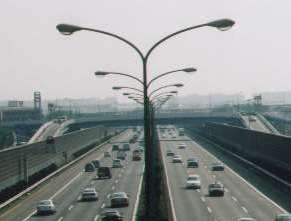
Please also visit the Actual Example of planning page to compare different transports. Bus (Intercity) Intercity bus network covers most cities in Japan due to the recent extension of expressway. They run almost as fast as Limited Express trains (slower than Shinkansen, of course). They usually cost cheaper than Limited Express trains. And most overnight buses are fairly comfortable equipped with wide three-row seats. Bus has some disadvantages, however. There is no bus company in Japan that operates at nation-wide level such as Greyhound bus in United States. Most companies specialize in the routes from big city to particular region. This means that there is no convenient bus pass and each bus route does not care about connection with other routes at all. Stopover on the way is not allowed either. Besides, railway is better than bus in terms of the information and English signs to foreign tourist.
And often they are caught in heavy traffic especially in the case of routes to Tokyo. Air There is extensive domestic air network in Japan despite its size. In most cases, you can travel between two cities within three of four hours by air, including time between airport and downtown.
From Tokyo, air does not have large advantage in the case of travel within Honshu Island compared to Shinkansen. But it is much faster than rail when going to Hokkaido or Kyushu Island, and more than 90 per cent of passengers choose air in those cases, indeed. In many small discount ticket shops in Tokyo or Osaka, many kinds of cheaper air tickets are also available. You can also get many discount package tours provided by travel agencies. In those tours you will get the combination of air and hotel ticket, whose total prices are sometimes amazingly cheap. They are advertised in some travel magazines or travel agency offices in Japan, though finding such information requires some Japanese language skills and experiences of course.
For passengers less than twenty-two years old, there are very good discount service called 'Skymate'. Paying only 1,000 yen, you get the membership of 'Skymate' valid for one year, and can use all air routes by 50 per cent off. You can not make previous reservation when using this advantage, and have to wait for the next flight if seats are occupied. Ferry Japan is surrounded by sea and there are some long distance ferry services. They are slow but quite comfortable and cheaper than other transports. They are often equipped with video rooms, large Japanese-style public bath, game machines, and so on. Passengers can ship their own car with them. Most of ferry routes are aimed at travellers with much time. From Tokyo, there are ferry routes to Tomakomai (Hokkaido), Katsuura (Wakayama Prefecture), Tokushima and Kochi (Shikoku), Kitakyushu (Kyushu), and Okinawa.
There are also International ferry services
between Fukuoka and Pusan (South Korea), Osaka and Shanghai (China), Niigata and Vladivostok (Russia). Car Driving is on the left. Japan is a country of quite high population density and road condition is not so good. Around Tokyo, not only in downtown but also in its suburban areas, you can travel only ten or twenty kilometers' journey per hour. In metropolitan area, road capacity is much smaller than demand and roads are jamming throughout the day, even in weekends. Transport there is heavily dependent on railways, mass transit.
Even outside metropolitan area, driving is not so comfortable in Central Japan region unless using expensive expressway. Urban area and road side shops last for hours along the main roads.
Namely Hokkaido is quite comfortable place to drive with its exceptionally low population density by Japanese standard. In these areas, traveling by car is a good choice. It does not mean that police allows common overspeed and there is a risk of being heavily fined. Its possibility is not particularly high but if unlucky you will be caught, even though other cars are running at the similar speed. In expressways, you should expect some traffic jam around Tokyo and Osaka in weekends. During New Year holidays, Golden Week holidays at the beginning of May, and O-bon holidays in mid August, the condition is worst and traffic jam sometimes extends up to fifty kilometers' long! However, except weekends and these seasons, traffic condition in intercity expressway is not so bad and traffic jams rarely happen outside the expressways around metropolis. Expressways impose quite expensive fare, 4,100 yen from Tokyo to Shizuoka (160 km) and 7,200 yen from Tokyo to Sendai (330 km), for example. They are nearly equally to the fare of Limited Express trains.
But considering the bad condition of other roads, perhaps you will choose expressway when traveling some distance. Using expressway, usually a bit faster than Limited Express trains unless caught in traffic jam. |